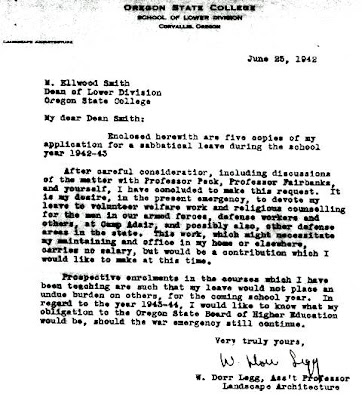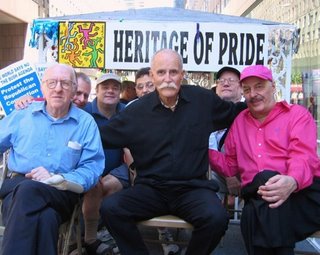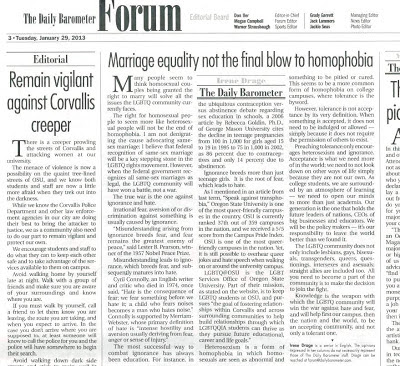PHOTO: by an interesting coincidence, the front page of my local newspaper ran two stories on the proposed vote to legalize gay marriage in Oregon and the anti-gay Pope resigning, which are loosely related: Tracy Wilkinson, Los Angeles Times, "Pope Resigns, As his reign ends, Benedict represents old-Curch values in a rapidly changing world," Gazette-Times, Feb. 12, 2013, p. A1, published online as "Pope Benedict faced worldwide challenges The difficulties and hard work confronting the now-85-year-old pope only multiplied during his eight-year reign," latimes.com Feb. 11, 2013 and Jonathan J. Cooper, Associated Press, "Same-sex marriage backers plan Oregon vote," Gazette-Times, Feb. 12, 2013, p. A1, published online as "Same-sex marriage backers plan Oregon vote," ap.org Feb. 11, 2013
UPDATE (2/27/13): Minnesota, the state Jack Baker married another man in 1970, might finally re-legalize gay marriage (note there wasn't any law against gay marriage when Baker married in 1970). See articles by Baird Helgeson under Minnesota legislature, "Legislators take on proposal to legalize same-sex marriage in Minnesota," startribune.com posted Feb. 27, 2013 and Tim Blotz , "Bipartisan 'Freedom to Marry' bill introduced at Minnesota Capitol," KMSP FOX TV Channel 9 myfoxtwincities.com posted Feb. 27, 2013. Scott Dibble (politician) is the openly gay legislator behind it. Hat tip to blog by Jim Burroway, The Daily Agenda for Wednesday, February 27from Box Turtle Bulletin by Jim Burroway posted Feb. 27, 2013, which also mentioned the Minneapolis WCCO radio and TV star Cedric Adams.
PHOTO: May 18, 1970 Michael McConnell and Jack Baker were married by Hennepin County Minnesota Justice of the Peace. See previous posts Life Magazine gay marriage 1971 (11/20/08), Gay marriage pioneer Jack Baker starts blog (confirmed) (4.4.12), and Sam Champion gay marriage 2012 vs. 1970 Jack Baker (1/8/13).
END OF UPDATE (2/27/13)
Also see:
- KATU.com Staff and Associated Press, "Supporters start push to allow same-sex marriage in Oregon," katu.com posted Feb. 11, 2013
- Michelangelo Signorile, "The Time I Called Pope Benedict 'The Devil' to His Face," signorile.com posted Feb. 11, 2013
- Michelangelo Signorile, "Pope Benedict's Successor: Why He Will Be Even More Anti-Gay," huffingtonpost.com posted Feb. 13, 2013
- Jim Burroway, "Pope Benedict XVI Announces Resignation," boxturtlebulletin.com posted Feb. 11, 2013
- Timothy Kincaid, "Oregon to take marriage back to the voters," boxturtlebulletin.com posted Feb. 11, 2013
 PHOTO: ONE Magazine was ahead of its time when it mentioned the idea of "homosexual marriage" in 1953 long before "gay marriage" or same-sex marriage became a cause of some gay liberationists. Former Oregon State University Assistant Professor of Landscape Architecture W. Dorr Legg was one of the major contributors to the ONE homophile magazine and he was a conservative who probably saw gay marriage as being a conservative value. (See James T. Sears, PhD, "1953: When ONE Magazine, Headlined 'Homosexual Marriage,'" GayToday.com posted Aug. 11, 2003 and my previous posts Sam Champion gay marriage 2012 vs. 1970 Jack Baker (1/9/13), Slippery slope argument against marriage equality is predictable (6/22/12), OSU W. Dorr Legg homosexual marriage 1953 vs. CA Prop 8 2010 (8/22/10), Gay free speech victory 50th anniversary (1/18/08) and Jack Baker gay marriage theory was right (4/8/09))
PHOTO: ONE Magazine was ahead of its time when it mentioned the idea of "homosexual marriage" in 1953 long before "gay marriage" or same-sex marriage became a cause of some gay liberationists. Former Oregon State University Assistant Professor of Landscape Architecture W. Dorr Legg was one of the major contributors to the ONE homophile magazine and he was a conservative who probably saw gay marriage as being a conservative value. (See James T. Sears, PhD, "1953: When ONE Magazine, Headlined 'Homosexual Marriage,'" GayToday.com posted Aug. 11, 2003 and my previous posts Sam Champion gay marriage 2012 vs. 1970 Jack Baker (1/9/13), Slippery slope argument against marriage equality is predictable (6/22/12), OSU W. Dorr Legg homosexual marriage 1953 vs. CA Prop 8 2010 (8/22/10), Gay free speech victory 50th anniversary (1/18/08) and Jack Baker gay marriage theory was right (4/8/09))
PHOTO: Letter signed by Oregon State University Assistant Professor of Landscape Architecture W. Dorr Legg from the original paper in OSU personnel files that are now stored on microfiche in the OSU Archives, Corvallis, Oregon. The letter, dated 1942, was requesting a sabbatical leave to allow Dorr to spread his "Christian Science" religious beliefs to soldiers at Camp Adair north of Corvallis, Oregon during World War II. Legg was a cofounder of the 1950s homophile political movement for homosexuals and the present-day Loc Cabin Republicans. (See Thomas Kraemer, "Corvallis, Oregon State University gay activism 1969-2004," OutHistory.org posted June 2010 and see my previous posts:
- W. Dorr Legg OSU archives records 1935-1942 (7/31/10)
- FBI files on gay OSU professor 1956 (7/7/10)
- OSU W. Dorr Legg homosexual marriage 1953 vs. CA Prop 8 2010 (8/22/10)
- Gay Oregon Professor 1935 (9/16/06)
- OSU professor recognized equality hypocrisy decades ago (6/5/12)
- Thomas Kraemer, "Corvallis, Oregon State University gay activism 1969-2004," OutHistory.org posted June 2010
- OSU professor recognized equality hypocrisy decades ago (6/5/12)
- OSU gay marriage and the Corvallis Creeper (2/9/13)
- Churches self-destruct over gay marriage (6/18/09)
- Protection of Religion Amendment - GT letter (11/23/08)
- Slippery slope argument against marriage equality is predictable (6/22/12)
- Sam Champion gay marriage 2012 vs. 1970 Jack Baker (1/9/13)














